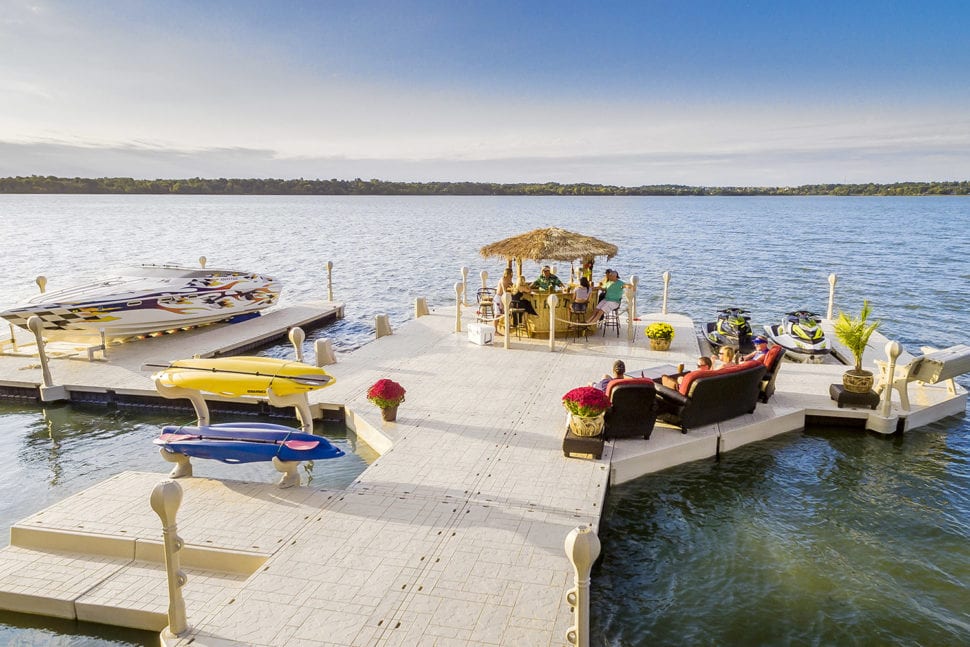Upgrade Your Waterside With Durable Floating Docks
Updating your beachfront with sturdy floating docks can significantly enhance both functionality and aesthetics, giving a versatile remedy for various water activities. With a range of products readily available, consisting of low-maintenance alternatives and traditional timber, selecting the best dock can match your individual design and satisfy sensible demands.
Benefits of Floating Docks
Floating docks deal a multitude of advantages that boost their charm for numerous maritime applications. Among the key benefits is their flexibility to transforming water levels - floating docks. Unlike typical fixed docks, floating docks increase and loss with the tide, making sure consistent accessibility for watercrafts and watercraft no matter of ecological conditions. This attribute significantly decreases the threat of damages to vessels, as they remain safely moored even during variations in water deepness.
In addition, floating docks are much easier to transfer and mount, giving versatility for short-lived or seasonal use. Their modular layout enables personalization to fit details needs, whether for exclusive marinas, household beachfronts, or industrial applications.
Moreover, floating docks develop very little disruption to the aquatic atmosphere, protecting regional communities and lowering the chance of disintegration. They likewise supply improved safety and security for users, as their resilient nature supplies an extra flexible surface than rigid structures.
Furthermore, floating docks can promote a diverse series of activities, such as angling, swimming, and entertainment boating, making them a beneficial possession for waterside advancement. Their adaptability and practicality make floating docks a favored choice for a variety of marine tasks.
Choosing the Right Products
Picking suitable products for floating docks is crucial to their longevity, performance, and general effectiveness. When selecting products, take into consideration variables such as environmental direct exposure, upkeep needs, and structural integrity. Typical materials include timber, plastic, aluminum, and composite alternatives, each offering unique benefits and negative aspects.
Wood, while visually pleasing, requires regular upkeep to avoid rot and degeneration. Pressure-treated timber can improve longevity, but it might still yield to water damages in time. Plastic drifts, commonly made from high-density polyethylene, are resistant to corrosion and require marginal upkeep, making them an attractive choice for low-maintenance applications.
Aluminum is one more viable alternative, recognized for its stamina and lightweight homes. It is resistant to rust and can hold up against extreme climate condition, although it might be much more expensive than other materials. Compound products combine the very best features of timber and plastic, providing a low-maintenance and resistant alternative that simulates the look of timber without the associated drawbacks.
Ultimately, the selection of material should align with the planned use, environmental considerations, and budget restrictions, guaranteeing a practical and long lasting floating dock that fulfills your particular requirements.
Setup Process Introduction
The effective installation of a floating dock relies upon careful preparation and implementation, ensuring that it runs efficiently in its desired environment. The initial step involves analyzing site conditions, consisting of water deepness, shoreline attributes, and prevailing weather patterns, which will inform the dock style and anchoring system.
Adhering to the site assessment, the following phase is to prepare the floating dock components. This consists of setting up the framework, safeguarding floats, and attaching any type of necessary hardware. It is essential to make certain that hop over to these guys all connections are waterproof and durable to stand up to aquatic conditions.
As soon as the dock is assembled, the setup process begins with placing the dock in the water. This can involve a crane or other lifting devices, particularly for bigger structures. Appropriate positioning is necessary for functionality and security.

Upkeep Tips for Durability
Normal upkeep is important for making sure the durability and optimal efficiency of a floating dock. To attain this, begin with routine inspections a minimum of two times a year, concentrating on the stability of the dock's framework, including the flotation protection devices and linking equipment. Try to find indications of wear, rust, or damage, and attend to any issues immediately to stop more deterioration.
Cleaning is one more crucial aspect of upkeep. Eliminate debris, algae, and barnacles from the dock's surface area to protect against unsafe conditions and keep visual appeal. Utilize a check these guys out soft brush and a mild detergent to stay clear of harming the dock's products.
Furthermore, make certain that the dock is correctly secured and secured to endure seasonal changes in water degrees and climate condition. Inspect the anchoring system for stability and make adjustments as necessary.
Enhancing Your Outside Visual
To create an aesthetically enticing outdoor area, incorporating a drifting dock can substantially enhance the overall visual of your waterside property. Floating docks are not just useful but can likewise function as a striking focal factor that enhances the natural environments - floating dock company. Readily available in various materials and layouts, these docks can be customized to match your property's architectural design and landscape
The enhancement of ornamental elements, such as incorporated illumination or fashionable see this website railings, even more raises the dock's visual allure. Think about using natural timber surfaces, which blend flawlessly with the environment, or choosing contemporary products like light weight aluminum or composite decking that provide a smooth, modern appearance.
Purposefully positioning planters or seating areas on or around the dock can create inviting spaces that motivate relaxation and satisfaction of beachfront views. Additionally, integrating colors and appearances that integrate with your landscape will certainly produce a natural visual throughout your exterior area.

Conclusion

Updating your waterside with resilient floating docks can substantially enhance both performance and looks, giving a versatile service for numerous water tasks. Unlike standard fixed docks, floating docks rise and loss with the tide, making certain constant availability for boats and watercraft regardless of ecological conditions.Picking appropriate products for floating docks is essential to their durability, efficiency, and general effectiveness.As soon as the dock is put together, the installment process begins with placing the dock in the water.In recap, floating docks offer many benefits, including flexibility to water degree changes and a range of material options.